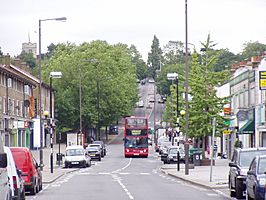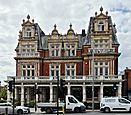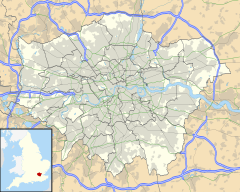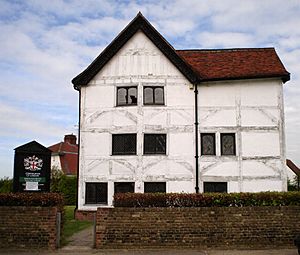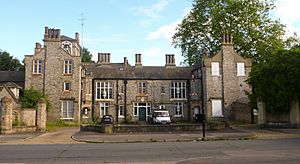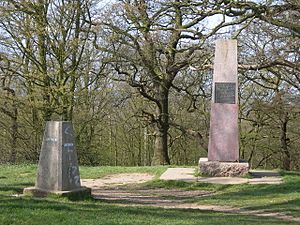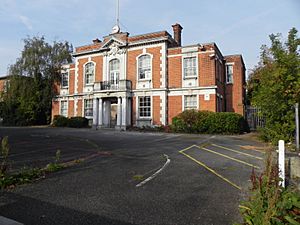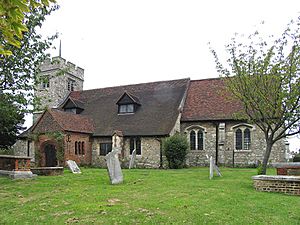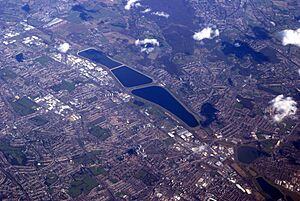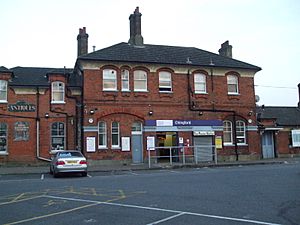Chingford facts for kids
Quick facts for kids Chingford |
|
|---|---|
|
Clockwise from top: Old Church Road in Chingford Mount, Queen Elizabeth's Hunting Lodge, Kings Head Hill and War Memorial, Station Road, and the former Bull & Crown public house
|
|
| Population | 70,583 (2021 Census) |
| OS grid reference | TQ379935 |
| • Charing Cross | 9.2 mi (14.8 km) SW |
| London borough | |
| Ceremonial county | Greater London |
| Region | |
| Country | England |
| Sovereign state | United Kingdom |
| Post town | LONDON |
| Postcode district | E4 |
| Dialling code | 020 |
| Police | Metropolitan |
| Fire | London |
| Ambulance | London |
| EU Parliament | London |
| UK Parliament |
|
| London Assembly |
|
Chingford is a town located in east London, England. It is part of the London Borough of Waltham Forest. Chingford is about 9 miles (15 km) north-east of Charing Cross, a central point in London. It is surrounded by other towns like Waltham Abbey to the north and Walthamstow to the south. In 2021, about 70,583 people lived here.
Chingford has a long history. It was once an old parish in Essex. The town grew a lot from the late 1800s, becoming part of the bigger London area. It joined the Metropolitan Police District in 1840. Later, in 1965, Chingford merged with Walthamstow and Leyton to create the new borough of Waltham Forest, which is now part of Greater London.
Contents
- Understanding the Name of Chingford
- Exploring Chingford's Geography
- A Look at Chingford's Past
- Important Places and Landmarks
- Churches in Chingford
- How Chingford is Governed
- Chingford's Population and Diversity
- Local Sports Teams in Chingford
- Getting Around Chingford: Transport
- Education in Chingford
- Famous People from Chingford
- Images for kids
Understanding the Name of Chingford
The name "Chingford" has an interesting history. The River Ching flows through the area, and there are several fords (shallow places to cross a river) nearby. However, it is thought the town was named before the river.
Some old records from 1066 AD call the area "Cingefort". The word ching in Old English meant "king". So, Chingford might mean "the King's ford" or "the King's river". This idea makes sense because royalty, like King Henry VIII and Queen Elizabeth I, used the area for hunting many centuries ago. Queen Elizabeth's Hunting Lodge is still here today. There is also evidence that King Harold Harefoot lived in Chingford in the 11th century.
Another idea is that the name comes from "Shingly Ford," meaning a ford with small, loose stones. But this is unlikely because the word "shingle" was not used until much later than the name "Cingefort" appeared.
Exploring Chingford's Geography
The area that used to be the old parish and later the Municipal Borough of Chingford includes several smaller areas. These are Chingford Green, Chingford Hatch, Chingford Mount, Friday Hill, North Chingford, and South Chingford.
A Look at Chingford's Past
How the Railway Changed Chingford
Chingford railway station opened in 1873. This brought many more visitors to the area. People used Chingford as a way to get to Epping Forest.
Epping Forest: A Gift to the People
Epping Forest was given to the public by Queen Victoria in 1878. This was done under the Epping Forest Act. This law made sure the forest would stay open and free for everyone to enjoy.
Historic Hotels and Their Stories
The Royal Forest Hotel opened in 1880. It was located on Ranger's Road, making it a popular spot for day-trippers visiting Epping Forest. It is right next to the historic Queen Elizabeth's Hunting Lodge. The royal family used this lodge when they hunted deer in the forest during the 1600s.
At the other end of Station Road, the King's Head Hotel has been around since at least the 1730s. It also became more popular as more people visited Chingford. Today, it is still a busy place. The inside has been updated, but the outside still looks like it did in its early days.
Important Places and Landmarks
One very important landmark in Chingford is Queen Elizabeth's Hunting Lodge. It was first called the Great Standing. King Henry VIII had it built in 1543. It was used like a grandstand to watch deer hunting. Over time, the building has been changed a lot. It is located on Chingford Plain inside Epping Forest. You can visit the lodge, and it is protected by the Epping Forest Preservation Act.
Butler's Retreat: A Historic Cafe
Next to the Hunting Lodge is Butler's Retreat. This building was originally a barn built in the mid-1800s. It is now a Grade II listed building, which means it is historically important. It is one of the few old "retreats" left in the forest. These retreats used to serve non-alcoholic drinks as part of the Temperance movement. Butler's Retreat closed in 2009 but was renovated and reopened as a cafe in 2012.
Friday Hill House and Its Connections
Friday Hill House on Simmons Lane was built in 1839. It was a large manor house owned by Robert Boothby Heathcote. He was the lord of the manor and also the local church's rector. He paid for the building of the church of St Peter and St Paul, Chingford. He is buried in his family's vault at All Saints' Churchyard. The house has been used as an education center.
The Pole Hill Obelisk
On Pole Hill, there is a granite obelisk. It was put there in 1824 by the Astronomer Royal, John Pond. Its purpose was to mark true north for the telescopes at the Royal Observatory in Greenwich. It was placed on high ground along the Greenwich Meridian line. Later, when the meridian was re-measured, the obelisk was found to be about 19 feet (5.8 meters) west of the new line. Today, a nearby triangulation pillar marks the modern meridian line.
Chingford Town Hall
Chingford Town Hall was built in 1929 and is on The Ridgeway. It was also known as the Chingford Municipal Offices. The building has since been turned into apartments.
Churches in Chingford
All Saints' Church
All Saints' Church in Chingford Mount is often called the Old Church. It is a Grade II* listed Church of England church on Old Church Road. Some parts of the church are from the 12th and 13th centuries. It is now part of the parish of St Peter and St Paul, Chingford, which became the main parish church in 1844. The church is on top of Chingford Mount. From there, you can see the reservoirs of the Lea Valley. Right across from the church is Chingford Mount Cemetery.
Our Lady of Grace & Saint Teresa of Avila
The Roman Catholic church of Our Lady of Grace & Saint Teresa of Avila is located at the corner of Kings Road and Station Road. It is next to St Mary's Catholic Primary School. The current building, which has a half-timbered style, was built in 1931. It stands on the site of an earlier church from 1919.
How Chingford is Governed
Chingford in Parliament
Chingford is part of the Chingford and Woodford Green area for the UK Parliament. This area includes six Chingford wards and two wards from Redbridge. Iain Duncan Smith has been the Member of Parliament (MP) for this area since 1992. An MP is a person elected to represent a group of people in the national government.
Chingford in London's Local Government
Chingford is part of the London Borough of Waltham Forest. This borough also includes Walthamstow, Leyton, and Leytonstone. Chingford itself is divided into six council wards:
- Chingford Green
- Endlebury
- Valley
- Larkswood
- Hatch Lane and Highams Park North
- Hale End and Highams Park South
Most wards have three councillors, who are elected to represent local people. The London Borough of Waltham Forest is currently run by the Labour party.
Chingford and Waltham Forest are also part of the North East constituency for the London Assembly. This assembly helps govern London.
Before 1965, Chingford was its own municipal borough. It started as a rural parish, then became an urban district in 1894, and a municipal borough from 1938 to 1965.
Chingford's Population and Diversity
In 2021, the population of Chingford was 70,583. This was an increase from 66,211 people in 2011. The town has become much more diverse between these two censuses. Less than half of the people (49.1%) now identify as White British. This is a decrease from 62.7% in 2011 and 80.5% in 2001.
The population numbers for Chingford are based on combining the populations of its six wards.
Local Sports Teams in Chingford
- Egbertian FC is Chingford's oldest football club. It started in 1928 and plays in the Amateur Football Combination.
- Ridgeway Rovers Youth Football Club is a local club. Famous players like David Beckham, Andros Townsend, and Harry Kane used to play here.
- Chingford Rugby Club was also founded in 1928. Its ground is on Waltham Way.
- Chingford Cricket Club is on Forest Side. It is thought to have started in 1884. The club plays in The Shepherd Neame Essex League.
- Chingford Town Football Club was restarted in 2018 by local schoolboys.
- King George Sailing Club began in the 1970s. It offers dinghy sailing and windsurfing on a large body of water. The club has good facilities and encourages young people to sail. The Royal Yachting Association has given it Volvo Champion Club status.
Local Districts in Chingford
- Highams Park
- Friday Hill
- Hale End
- Chingford Hatch
- Chingford Mount
Places Near Chingford
- Woodford, London
- Walthamstow
- Edmonton, London
- Leyton
- Tottenham, London
- Buckhurst Hill
- Loughton
- Sewardstone
Getting Around Chingford: Transport
Train Services
Chingford is served by Chingford railway station. This station is the end of the London Overground Lea Valley lines that come from Liverpool Street station in the City of London. Chingford is the only station in Waltham Forest that is in London fare zone 5.
There is also a station at Highams Park, which is in zone 4. Chingford used to have a train link to Stratford. This link was removed in 1970, and there have been efforts to bring it back.
Bus Routes
Many London Buses routes serve Chingford, connecting it to various parts of London. These include routes like the 97 to Stratford City, the 179 to Ilford, and the 212 to Walthamstow St James St. There are also night bus services like the N26, which goes from Victoria to Chingford Station.
Education in Chingford
Chingford has several secondary schools for students:
- Chingford Foundation School
- Heathcote School
- Normanhurst School
- South Chingford Foundation School
- Lime Academy Larkswood
Famous People from Chingford
Many notable people have connections to Chingford:
- Charles W. Alcock, a founder of the Football Association and creator of the FA Cup, lived in Chingford.
- Dame Louisa Aldrich-Blake, a famous surgeon, was born in Chingford.
- David Beckham, a former England football captain, grew up in Chingford. He went to Chingford Foundation School and played for a local team, Ridgeway Rovers F.C.
- Sir Winston Churchill was an MP for the Epping area, which included Chingford, from 1924 to 1945.
- Sir John Dankworth, a jazz composer, grew up in Highams Park.
- Alan Davies, a comedian, grew up in Chingford.
- Paul Di'Anno, a former singer for the band Iron Maiden, was born and grew up here.
- Sir Iain Duncan Smith has been the MP for Chingford and Woodford Green since 1992.
- Dwight Gayle, a football player, is from Chingford.
- Durrty Goodz, a well-known grime musician, is from Chingford.
- Peter Greenaway, a film director, grew up in Chingford.
- Sir Peter Harding, a former Chief of the Air Staff, went to Chingford County High School.
- Steve Hillage, a guitarist, is from Chingford.
- Harry Kane, a Bayern Munich and England football player, is from Chingford and went to Lime Academy Larkswood and Chingford Foundation School.
- Sir Jony Ive, Apple's Chief Design Officer, was born in Chingford.
- John Lloyd, a graphic designer, grew up in Chingford.
- Professor Alan Mozley, a zoologist, was born in Chingford.
- Graeme Norgate, a video game music composer, was born and grew up in Chingford.
- Michael Nyman, a composer known for film scores, grew up in Chingford.
- Leslie Phillips, a comedy actor, lived in Chingford.
- Peter Sceats, a businessman, was brought up in Chingford.
- Faiza Shaheen, an academic, grew up in Chingford.
- Teddy Sheringham, a former England and Manchester United football player.
- John Sitton, a former Chelsea footballer, lives in Chingford.
- Kaikhosru Shapurji Sorabji, a composer and pianist, was born in Chingford.
- Andros Townsend, a Crystal Palace and England football player, grew up in Chingford.
- Michelene Wandor, a poet, went to school in Chingford.
- Geoffrey Winters, a composer, was born in Chingford.
Images for kids


